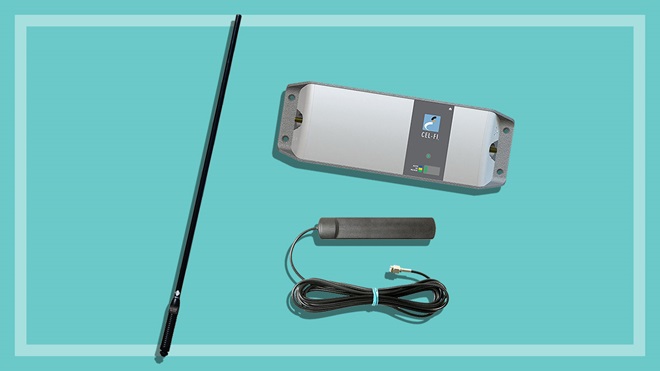Need to know
- Prices in this review range from $126.50 to $239, but the cheaper antennas didn't perform as well
- Both the RFI brand antennas performed well, with a maximum distance of 47.5km
- There were significant performance differences between antennas with the same manufacturer-claimed gain

Searching for a smartphone signal.
What is a high-gain antenna?
When you're travelling outside the major metropolitan areas, the best way to maximise mobile phone reception is to use a high-gain antenna.
High-gain antennas transmit more power to the receiver, increasing the strength of the signal it receives. This improves your chances of making a phone call even when the reception is very weak.

Reception detection - Farming Ahead engineer Josh Giumelli attaches antennas to the roof of a vehicle on the NSW test track.
What we found
- Cheaper antennas simply don't perform as well, despite their claims of high gain.
- The test results show significant performance differences between antennas that have the same claimed gain.
Which antennas performed best?
- The RFI CDQ7195 performed well across all testing bands and is reasonably priced.
- If you feel you need the extra punch provided by the RFI CD7197 then you can easily justify the extra price.
Both the RFI brand antennas recorded a maximum distance of 47.5km during testing, despite different stated gain ratings. Assuming radial uniformity, the measured distances to the tower quoted by RFI translate to significant increases in coverage area.
Tip: In many cases, antennas will be available at a lower price than the recommended retail price in the table below.
In a similar manner to our mobile phone testing, Farming Ahead engineers made a series of phone calls using five different mobile phone antennas driving away from a Next-G tower until the call dropped off.
Calls were repeated with the connection regained until the maximum distance from the tower was reached. While all antennas tested were multiband units with NextG, 4G and 4GX compatibility, only the 850MHz band was tested for voice calls, being the network with the greatest range from the tower.
Antennas were installed on the roof of a car – the location for greatest performance. These were coupled to a standard Cel-Fi Go unit for in-car calling.

Roof mounts on top of a vehicle.
Consider a Cel-Fi Go
This handy device is like a mini mobile tower that will improve reception for all the mobile phones in your car. Like the Cel-Fi repeaters used in homes experiencing marginal mobile signals, the Cel-Fi Go legally repeats and amplifies the signal in vehicles using a paddle antenna in the cabin.
- There is no dedicated cradle required for each different handset so cradles aren't required for each mobile phone.
- There is no loss in signal form the external antenna through a passive connection, meaning that the full benefit of the external antenna can be realised.
However, you probably don't need one if you don't travel enough in marginal reception areas or if there is only one mobile in the car.
A Cel-Fi Go costs from $1000 to $2000 with the various add-ons and connections for a car, caravan or even boat. You can find a model to suit your needs at the Cel-Fi website.
What about a dedicated mobile phone cradle?
A popular method for boosting a weak phone signal with an antenna is to fit a phone cradle to your vehicle with a passive antenna connection. Back in the dark days when mobile phones were called 'bricks' this was often the only option for using your mobile in the car.
Unfortunately, the connection is typically inefficient, losing between three to six decibels of signal across the passive connection and eliminating a lot of the gain in signal strength by having the external antenna.
Car cradles are also expensive to replace every time a phone handset is renewed and can often prevent other drivers from using the cradle if they have a different phone.
A sad farewell to the patch leads
Up until a few years ago, connecting an external car antenna to your mobile was as simple as plugging it into your phone handset antenna port using a patch lead which you will find either on the back of the phone or on the back of the phone if you take off the back cover.
While the phone was effectively tethered to the antenna, it generally provided good signal with very little loss. Several simple mobiles had this functionality as well as some smartphones from Samsung and Sony. However with the arrival of the fully sealed smartphone with no removable battery or back case.
This year is the first time the team had tested a group of phones without a single unit sporting an antenna port – removing one of the cheapest and most effective methods for improving phone reception.
We're on your side
For more than 60 years, we've been making a difference for Australian consumers. In that time, we've never taken ads or sponsorship.
Instead we're funded by members who value expert reviews and independent product testing.
With no self-interest behind our advice, you don't just buy smarter, you get the answers that you need.
You know without hesitation what's safe for you and your family. And our recent sunscreens test showed just how important it is to keep business claims in check.
So you'll never be alone when something goes wrong or a business treats you unfairly.
Learn more about CHOICE membership today
Stock images: Getty, unless otherwise stated.



